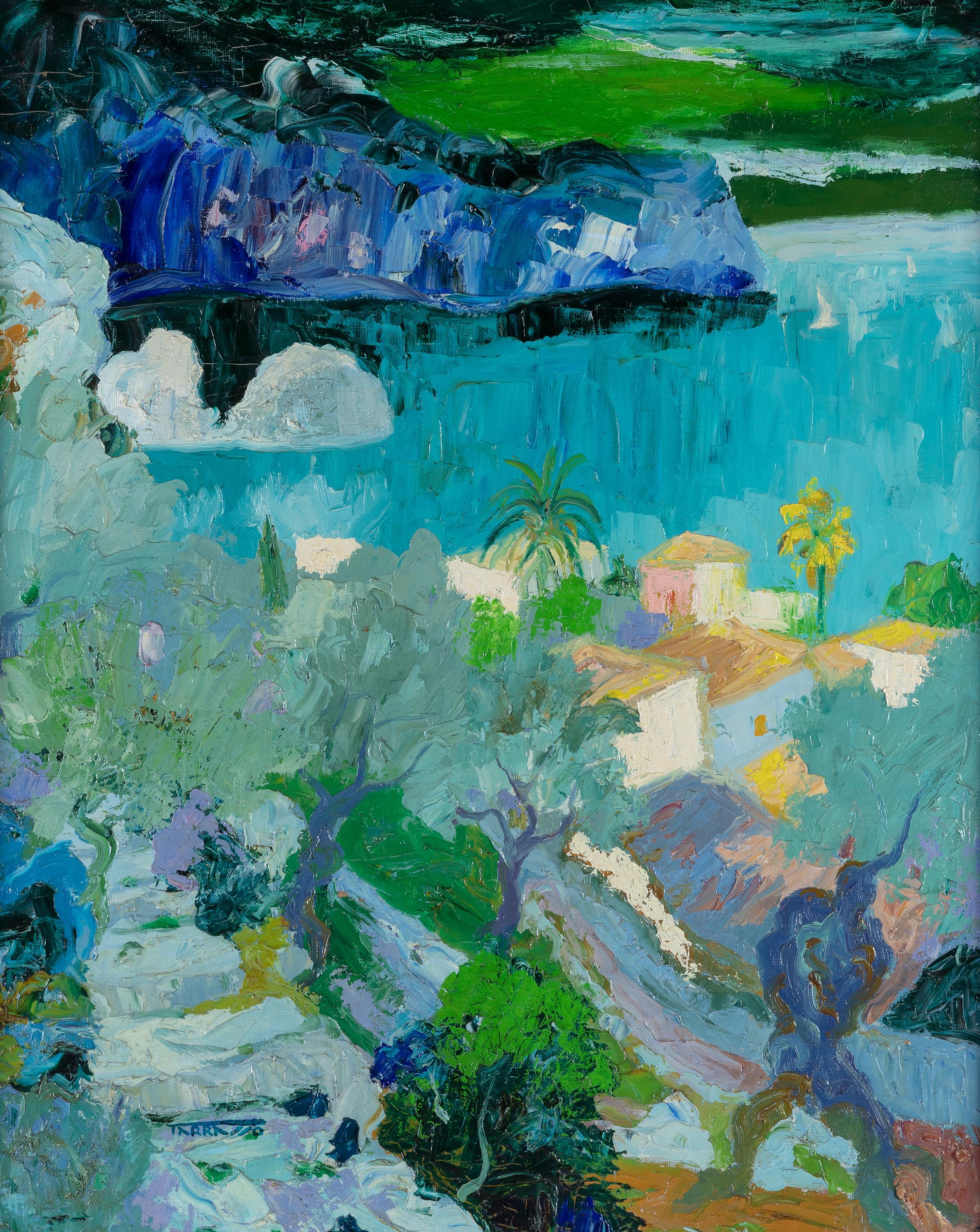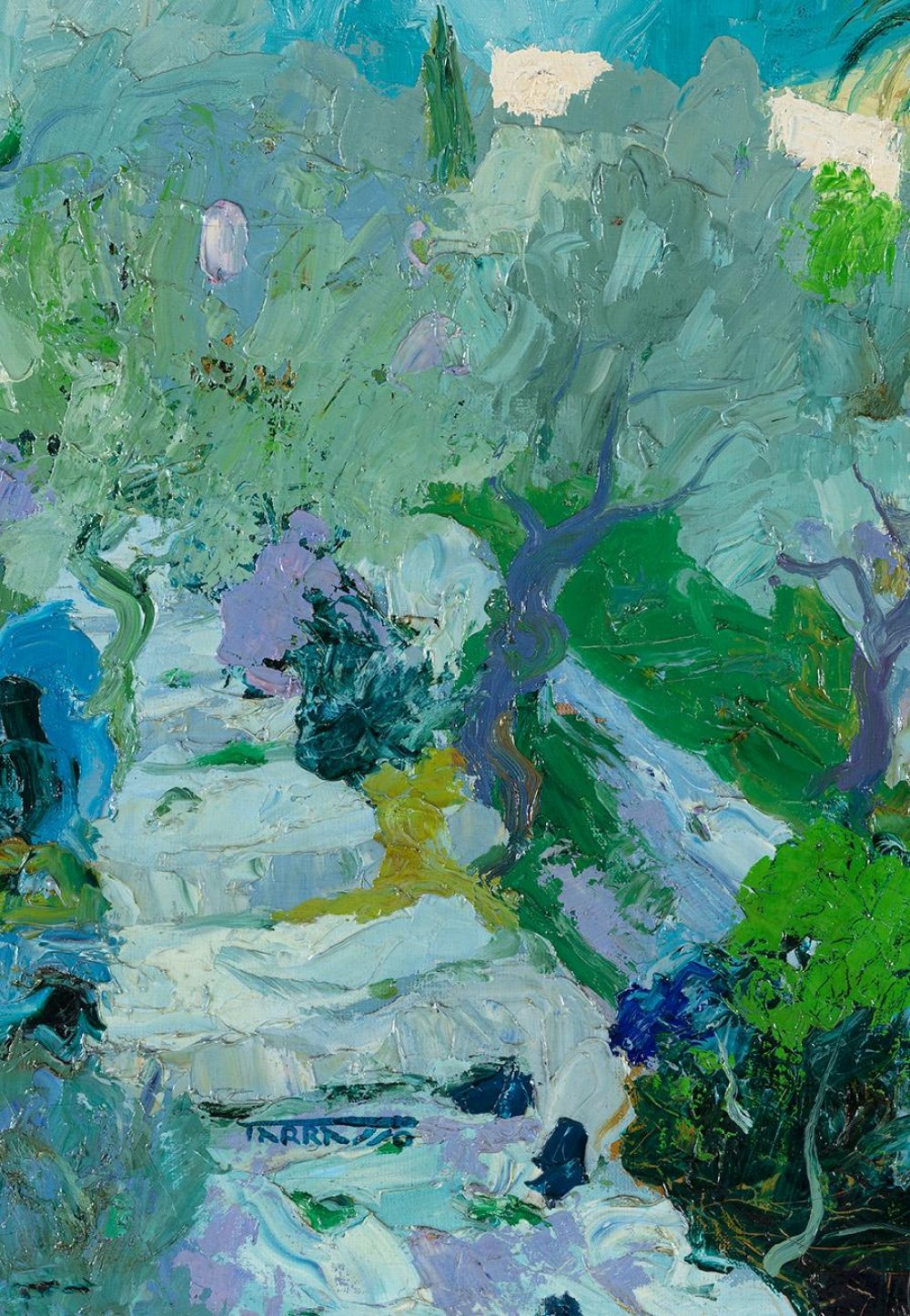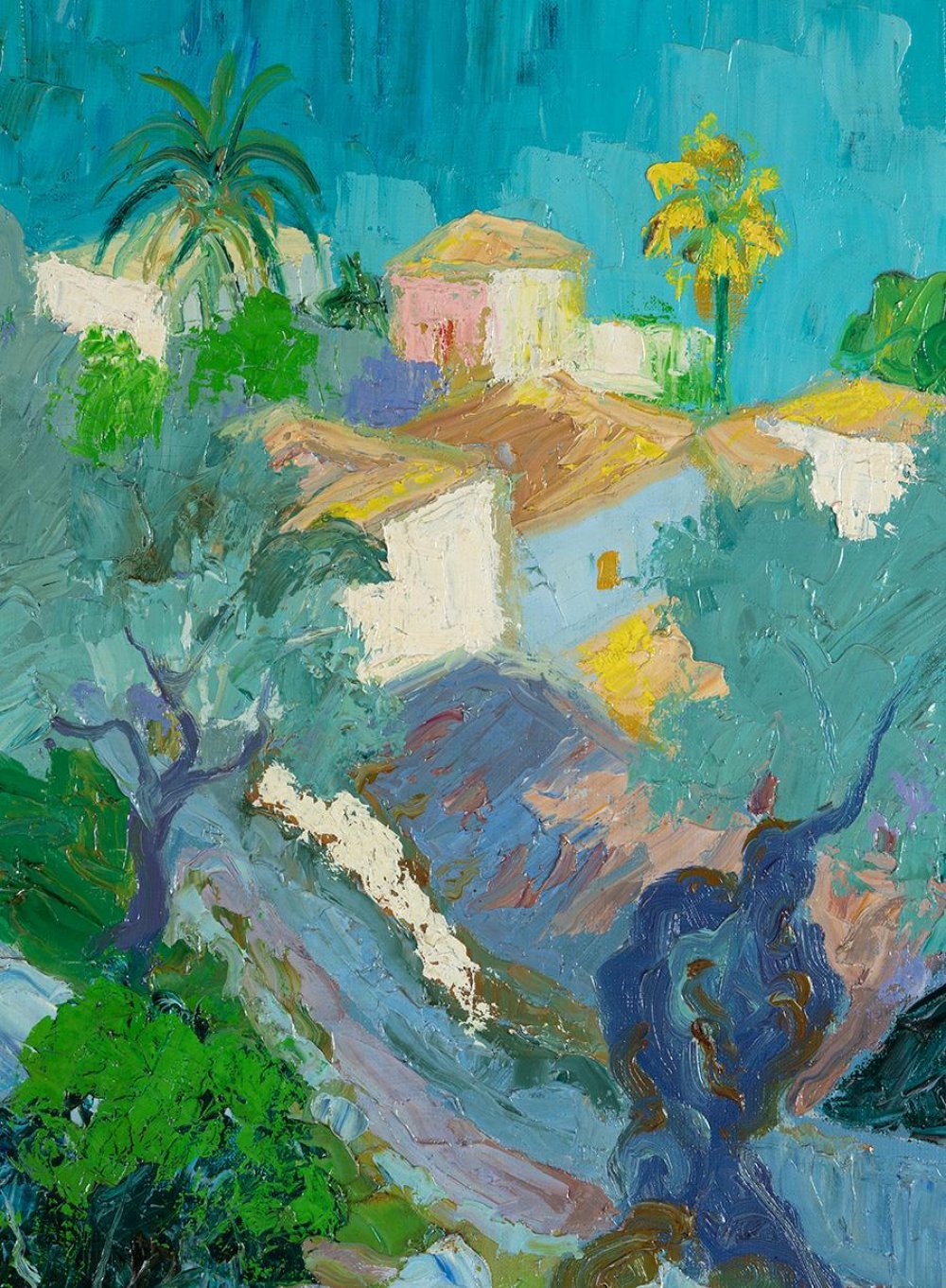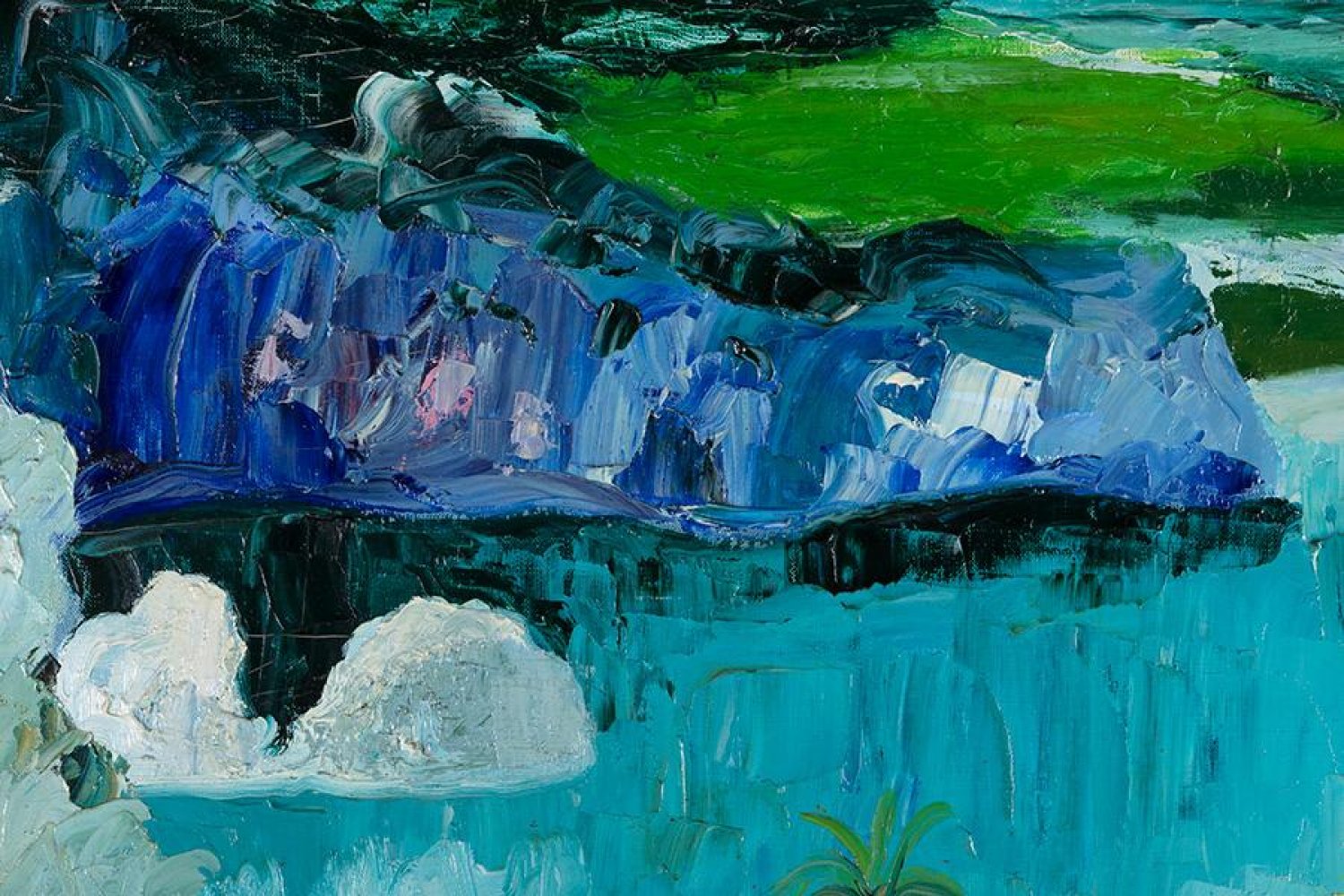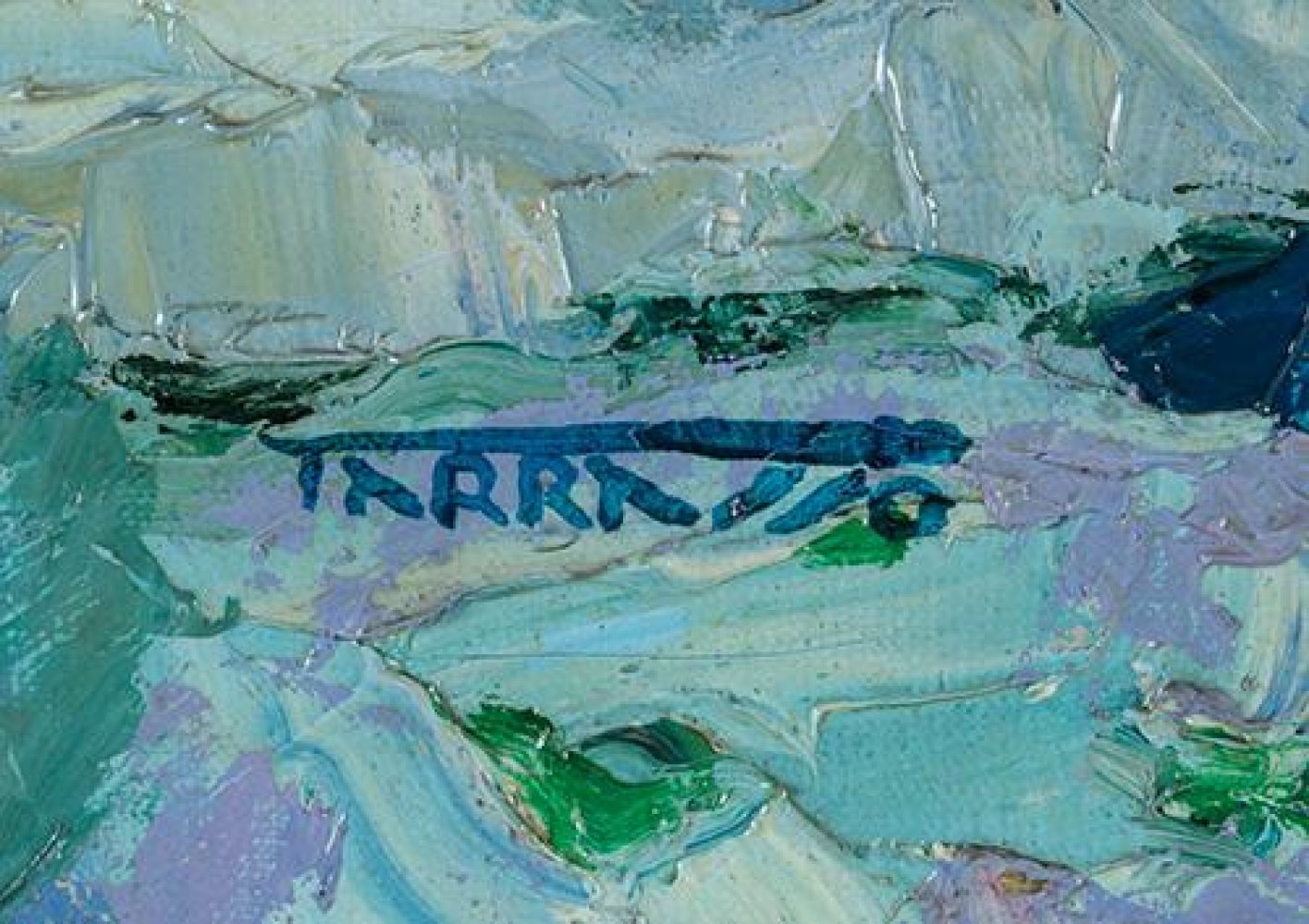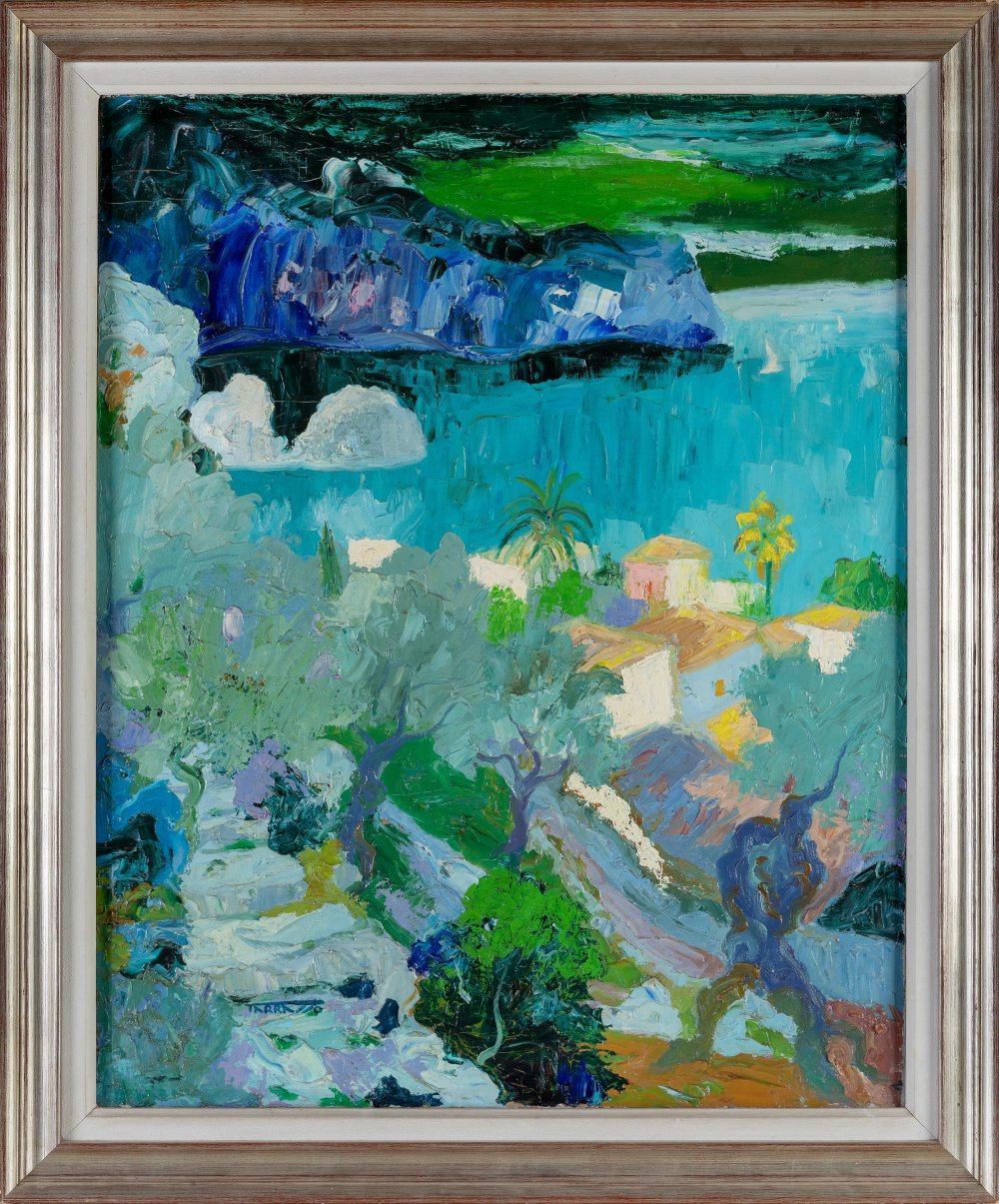13
CASIMIRO MARTÍNEZ TARRASSÓ (Barcelona, 1898 - 1980)."Cala Lluch Alcari", Majorca.Oil on canvas.
"Cala Lluch Alcari", Majorca.
Oil on canvas.
Signed in the lower area. Signed and titled on the back.
Measurements: 92 x 73 cm; 107 x 90 cm (frame).
In this canvas Tarrassó depicts a landscape constructed in depth with his personal language based on colour stains of Fauvist heritage. Thus, in the foreground he depicts a village dotted with little white houses, which guide our gaze towards a coastal nook in intense turquoise blue, after which the chromatic planes follow one after the other until we reach the background, enclosed by green tones. The vivid chromaticism is the result of a careful and thoughtful study, based on the juxtaposition of mainly cold tones, some brighter and others darker, to reinforce the three-dimensional construction of the space.
Known simply as Tarrassó, he trained at the Escuela de La Lonja in Barcelona. He completed his studies in Paris, where he had first-hand knowledge of the Fauvist works that were shaking the Parisian artistic scene at the time. He was above all a brilliant landscape painter, with a style characterised by its violent, vivid and very luminous colours. He followed in the footsteps of the great Catalan landscape painters, particularly Joaquín Mir, although with a clearly differentiated personality due in part to the impact Fauvism had on his artistic thinking. He cultivated still lifes and Catalan and Mallorcan landscapes. He held his first exhibition in 1928 at the Galerías Layetanas in Barcelona. From then on he held exhibitions in Barcelona, Madrid, Palma de Mallorca and Bilbao. In 1935 he visited Mallorca for the first time, and from 1940 onwards he had a studio there, specifically in Palma, where he lived for long periods and where he developed most of his artistic production. After the Civil War, during the 1940s, Tarrassó took part in several National Fine Arts Exhibitions in 1942, 1943 and 1950, and held a number of personal exhibitions in Barcelona, in galleries such as Augusta, Layetanas, Ars, etc., among them the one he held of Pyrenean landscapes in 1948, and the one of large canvases of Mallorcan landscapes that he presented in 1949. Although landscape was always the focus of his production, Tarrassó also produced works such as the mural decoration of the church of Santa Maria in Badalona. He also undertook a singular undertaking in Mallorca, setting up his easel in the Campanet Caves to capture the stalactites and stalagmites of its stony cavities, developing a series of works that he presented at the Galerías Costa in Palma in October 1948. Throughout his career Tarrassó was awarded the Pollença Prize at the 1st International Painting Competition in 1962; the Santiago Rusiñol Prize in 1972; and the medals obtained at various editions of the Salones de Otoño (Autumn Salons) in Palma de Mallorca: first prize in 1967 and 1973, and the medal of honour in 1970. Tarrassó's work is characterised by the great personality of his colouring. His obsession for chromatism determines a profoundly sensorial, vitalist and intuitive painting. He is represented in various national and international private collections, as well as in the Museum and Artistic Fund of Porreras (Mallorca) and the Museum of Modern and Contemporary Art of Palma.
"Cala Lluch Alcari", Majorca.
Oil on canvas.
Signed in the lower area. Signed and titled on the back.
Measurements: 92 x 73 cm; 107 x 90 cm (frame).
In this canvas Tarrassó depicts a landscape constructed in depth with his personal language based on colour stains of Fauvist heritage. Thus, in the foreground he depicts a village dotted with little white houses, which guide our gaze towards a coastal nook in intense turquoise blue, after which the chromatic planes follow one after the other until we reach the background, enclosed by green tones. The vivid chromaticism is the result of a careful and thoughtful study, based on the juxtaposition of mainly cold tones, some brighter and others darker, to reinforce the three-dimensional construction of the space.
Known simply as Tarrassó, he trained at the Escuela de La Lonja in Barcelona. He completed his studies in Paris, where he had first-hand knowledge of the Fauvist works that were shaking the Parisian artistic scene at the time. He was above all a brilliant landscape painter, with a style characterised by its violent, vivid and very luminous colours. He followed in the footsteps of the great Catalan landscape painters, particularly Joaquín Mir, although with a clearly differentiated personality due in part to the impact Fauvism had on his artistic thinking. He cultivated still lifes and Catalan and Mallorcan landscapes. He held his first exhibition in 1928 at the Galerías Layetanas in Barcelona. From then on he held exhibitions in Barcelona, Madrid, Palma de Mallorca and Bilbao. In 1935 he visited Mallorca for the first time, and from 1940 onwards he had a studio there, specifically in Palma, where he lived for long periods and where he developed most of his artistic production. After the Civil War, during the 1940s, Tarrassó took part in several National Fine Arts Exhibitions in 1942, 1943 and 1950, and held a number of personal exhibitions in Barcelona, in galleries such as Augusta, Layetanas, Ars, etc., among them the one he held of Pyrenean landscapes in 1948, and the one of large canvases of Mallorcan landscapes that he presented in 1949. Although landscape was always the focus of his production, Tarrassó also produced works such as the mural decoration of the church of Santa Maria in Badalona. He also undertook a singular undertaking in Mallorca, setting up his easel in the Campanet Caves to capture the stalactites and stalagmites of its stony cavities, developing a series of works that he presented at the Galerías Costa in Palma in October 1948. Throughout his career Tarrassó was awarded the Pollença Prize at the 1st International Painting Competition in 1962; the Santiago Rusiñol Prize in 1972; and the medals obtained at various editions of the Salones de Otoño (Autumn Salons) in Palma de Mallorca: first prize in 1967 and 1973, and the medal of honour in 1970. Tarrassó's work is characterised by the great personality of his colouring. His obsession for chromatism determines a profoundly sensorial, vitalist and intuitive painting. He is represented in various national and international private collections, as well as in the Museum and Artistic Fund of Porreras (Mallorca) and the Museum of Modern and Contemporary Art of Palma.
6th October - 19th & 20th Century Art
Sale Date(s)
Venue Address
General delivery information available from the auctioneer
Setdart offers Worldwide shipping
PICK UP IN ROOM: You can come and pick up your lots in our offices (Barcelona, Madrid or Valencia). At the moment of the withdrawal, you will be able to accept the current conditions of the lot by means of a document that you will sign.
YOU CAN SEND ANOTHER PERSON TO PICK UP: This person must present a signed authorization that you can find in our web page by accessing from BUY AT SETDART- LOGISTICS-DOWNLOAD AUTHORIZATION DOCUMENT. You can also send an e-mail with the requested data in AUTHORIZATION DOCUMENT to admin@setdart.com
Important Information
25% buyer´s premium
21% buyer´s premium at www.setdart.com
Terms & Conditions
The maximum period to pay the lots is 7 working days. You can pay either via bank transfer or with credit card through our platform www.setdart.com (we only accept VISA or Mastercard).
BUYER´S PREMIUM: 22% Hammer price + 21% VAT from the buyer´s premium
If your piece has more than 100 years, our Ministry of Culture requires an export certificate in order for the piece to leave the country. Note that if the piece goes inside the EU, there is no cost for the export certificate. If the piece goes outside the EU, there is a cost for the export certificate. You can find more information in our Ministry of Culture website: https://www.culturaydeporte.gob.es/en/cultura/patrimonio/exportacionimportacion/exportacion/tasas.html
INQUIRIES: admin@setdart.com
Setdart guides you through the entire process, from the time of award to the day you receive your lot. Our logistics team will be happy to manage your transport, and will advise you on the best shipping method with professionals from the sector used to handling works of art and jewelry.
WE OFFER WORLDWIDE DOOR TO DOOR SHIPPING
PICK UP IN ROOM: You can come and pick up your lots in our offices. At the moment of the withdrawal, you will be able to accept the current conditions of the lot by means of a document that you will sign.
YOU CAN SEND ANOTHER PERSON TO PICK UP: This person must present a signed authorization that you can find in our web page by accessing from BUY AT SETDART-LOGISTICS-DOWNLOAD AUTHORIZATION DOCUMENT. You can also send an e-mail with the requested data in AUTHORIZATION DOCUMENT to admin@setdart.com
SETDART IS NOT RESPONSIBLE FOR THE STATE OF THE PARTS ONCE THEY LEAVE OUR FACILITIES. MRW SHIPMENTS: Once the payment is made, your lot will be packed for shipment, the logistics department will send you an e-mail notifying you of the day it leaves our warehouse, changes of address cannot be made after receiving this e-mail.
INSURANCE INCIDENTS: Coverage for the value of the auction up to 3000 ? per shipment, if the value of the auction is higher, Setdart will send you a quote including the additional insurance. The insurance company WILL NOT BE RESPONSIBLE FOR THE SHIPMENT THAT EXCEEDS THAT AMOUNT AND IS NOT FULLY INSURED. MRW INCIDENTS: Maximum notification 48 hours after receipt, after which the insurance company WILL NOT BE RESPONSIBLE AND NO CLAIMS WILL BE ACCEPTED.
E-MAIL LOGISTICS: logistica@setdart.com
PICK UP YOUR MESSAGES: You can send your own messaging, prior notice via e-mail that your shipment is ready, please note 3 or 4 days in advance. This type of shipment is packaged so Setdart will provide you with a quote.
EXPENSES FOR STORAGE: We inform you that if the purchased lot is not picked up within a month, you will be charged 30€ per week per lot. Setdart Online S.L., owner of the web site "setdart.com", "setdart.net" and "setdart.org", acts as a company of Spanish nationality inscribed in the Volume 36955, sheet 182, page B-293056 of the Mercantile Registry, with registered office at Calle Aragó













